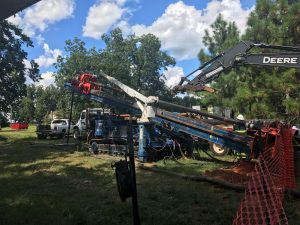Half a Mile of HDPE – Ingenuity and Adaptive Methods to Install DTD’s Longest Wells Ever

Client demands for ever-longer wells continues to push the limits of what can be accomplished using HDD to install horizontal remediation wells. These new challenges often result in having to adapt and extend existing technologies. This was the case on a recent project to install two horizontal wells, each over 2,500 feet in length, in sandy coastal sediments of the southeast US.
A gasoline release from over 40 years ago has resulted in a long contaminant plume extending over 1,000 feet down-gradient at approximately 135 feet below ground- and perhaps just as important, beneath high-value land. After operating a source area vertical well remediation system for 25 years, the responsible party decided to try to clean up the plume and remove the long term liability from their books. The consultant decided the only viable technology for the cleanup was using HDD to install horizontal air sparge wells. DTD worked with the project team to identify entry/exit areas that minimized the site impact, while still allowing the sparge well screens to be placed in the target area. In the end, the designed system placed a total of 2,000′ of well screen in the hot zone while minimizing surface impact for the local land owners.
The wells were installed to a depth of 145′ in mixed silty and sandy soils with heaving sands at depth. For most well installations, this mix of silts and sands is ideal for drilling and installation. However with a well of this length, cumulative wall drag along the well screen and casing during pullback of a traditional double-ended well through flowing sands meant using a high strength/high cost stainless steel well screen or coming up with a way to install a more cost effective HDPE well material, without breaking it. This was nearly perfect for DTD’s patented Knock-Off technology, but navigation at this depth with the KO bit is still under development, and therefore it could not be used on this project. DTD used a mix of traditional double-ended well installation and our KO technology to successfully install the wells using HDPE. This adaptation allowed the wells to be installed with a significant cost savings over a traditional stainless steel installation.
The wells were installed in August and September 2017, and the remediation system is currently being installed for system start up in the coming months. Ingenuity and technical creativity by adapting an already established installation technology have been the hallmark of another successful, record-breaking project.